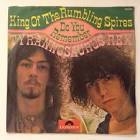Rock and roll music

From Wikipedia, the free encyclopedia
Leer más
Singles chronology
King of the Rumbling Spires
T-rex
Discográfica: Regal Zonophone · · Productor: Tony Visconti
CHARTS
UK
|
1
|
King of the Rumbling Spires
T-rex •
Marc Bolan/T-Rex •
w: Take 7 •
1969 /07
|
2:12 |
|
|
|
2
|
Do You Remember
T-rex •
w: Take 3 •
1969 /07
|
0:00 |
|
Album
No se encontraron resultados
Album
| "King of the Rumbling Spires" | ||||
|---|---|---|---|---|
| Single by Tyrannosaurus Rex | ||||
| B-side | "Do You Remember" | |||
| Released | July 1969 | |||
| Genre | Rock | |||
| Length | 2:07 | |||
| Label | Regal Zonophone | |||
| Songwriter(s) | Marc Bolan | |||
| Producer(s) | Tony Visconti | |||
| Tyrannosaurus Rex singles chronology | ||||
| ||||
Review
From Wikipedia, the free encyclopedia
Leer más
1969 single by Tyrannosaurus Rex
"King of the Rumbling Spires" is a single by Tyrannosaurus Rex, released in July 1969. It featured the duo of Marc Bolan and Steve Peregrin Took and was written by Bolan.[1] It was a minor chart hit, the first by the group to contain electric guitar instead of acoustic, and was Took`s last appearance with the duo on record.
Background
The track was significantly different from the earlier folk rock material and featured multiple electric guitars from Bolan (played on a Fender Stratocaster) and a toy drum kit from Took. Producer Tony Visconti played bass guitar and electric organ on the track.[2][3] Bolan had become influenced by the emerging late 1960s rock scene featuring bands such as Led Zeppelin, Jethro Tull and Humble Pie,[1] and wanted to record some experimental guitar work in the style he had used in his earlier stint with John`s Children.[2] However, the switch to harsh electric guitar was atypical of the duo`s acoustic-based sound, and would not be a regular feature for a few years.[4]
A review in Melody Maker called it "Bolan`s most commercial production to date" and called the song "electrified teenybopper". Several reviews hoped it would be a significant hit, and move Tyrannosaurus Rex away from their cult underground image.[1][3] In the event, it had a single week`s appearance on the charts, at number 44,[2] and was the last hit before Bolan regrouped the band as T. Rex to wider commercial success.[5] It was also the last single to feature Took, who Bolan fired shortly afterwards for wanting to record his own songs as well as Bolan`s, as well as creative and lifestyle differences between the pair.[6]
Originally issued as a stand-alone single, it was later included as a bonus track on reissues of the earlier album Unicorn.[7]
Personnel
- Marc Bolan - vocals, electric guitars
- Steve Peregrine Took - drum kit, percussion
- Tony Visconti - bass guitar, electric organ
From Wikipedia, the free encyclopedia
1969 single by Tyrannosaurus Rex
"King of the Rumbling Spires" is a single by Tyrannosaurus Rex, released in July 1969. It featured the duo of Marc Bolan and Steve Peregrin Took and was written by Bolan.[1] It was a minor chart hit, the first by the group to contain electric guitar instead of acoustic, and was Took`s last appearance with the duo on record.
Background
The track was significantly different from the earlier folk rock material and featured multiple electric guitars from Bolan (played on a Fender Stratocaster) and a toy drum kit from Took. Producer Tony Visconti played bass guitar and electric organ on the track.[2][3] Bolan had become influenced by the emerging late 1960s rock scene featuring bands such as Led Zeppelin, Jethro Tull and Humble Pie,[1] and wanted to record some experimental guitar work in the style he had used in his earlier stint with John`s Children.[2] However, the switch to harsh electric guitar was atypical of the duo`s acoustic-based sound, and would not be a regular feature for a few years.[4]
A review in Melody Maker called it "Bolan`s most commercial production to date" and called the song "electrified teenybopper". Several reviews hoped it would be a significant hit, and move Tyrannosaurus Rex away from their cult underground image.[1][3] In the event, it had a single week`s appearance on the charts, at number 44,[2] and was the last hit before Bolan regrouped the band as T. Rex to wider commercial success.[5] It was also the last single to feature Took, who Bolan fired shortly afterwards for wanting to record his own songs as well as Bolan`s, as well as creative and lifestyle differences between the pair.[6]
Originally issued as a stand-alone single, it was later included as a bonus track on reissues of the earlier album Unicorn.[7]
Personnel
- Marc Bolan - vocals, electric guitars
- Steve Peregrine Took - drum kit, percussion
- Tony Visconti - bass guitar, electric organ



